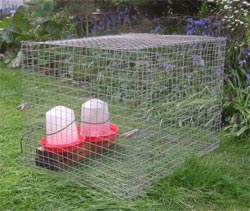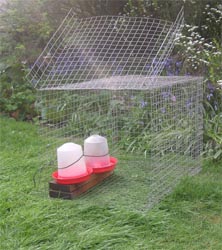How to make a broody coop to stop your chickens and bantams being broody (takes 1 hour to make)
Posted by Fiona Nevile in Chickens | 130 comments “Two of my hens are broody.” Bunty was exasperated.
“Two of my hens are broody.” Bunty was exasperated.
“We’ve got a broody one too.”
This was our first summer of keeping bantams (a small friendly breed of chicken).
Bunty continued, “I wish I hadn’t suggested Bantams. I’ve discovered that they go broody at the drop of a hat.”
Years ago Bunty had kept chickens commercially. Those were a type of chicken bred for laying that rarely go broody.
She thought that she had the answer to our dilemna.
“We need anti broody coops. You’re good at making things. Why don’t you make a couple?”
My heart sank. I thought that they would take hours to make, imagining a sort of dog kennel with a wide gauge wire mesh floor.
To stop a hen being broody you need to stop her from settling comfortably. The trick is to construct a cage with a floor made of large wire mesh ( with at least 1 inches squares). Set the cage on bricks so that the floor is suspended, keeping the bricks to the outside edges so that she can’t sit on them. Provide a small drinking fountain and feeder within the cage and pop her in. She won’t be able to settle on the wire mesh floor and within a few days will get over her broodiness.
I went to bed early and woke at four. In the still cold light I realised that the entire cage could be made of wire mesh. I went to the garden centre after breakfast and bought three sheets of wire mesh measuring 90cm x 60cm. The cage is 60 cm long and 43 cm high and 43 cm wide This allows for an overlap at the joins.
Our broody coop is simple to make. Lay the wire on a flat surface, and bend 2 cm of wire mesh to a 90 degree angle along a 60 cm side. Then lift the opposite end and press it into the angled flap. Press firmly on the bulgy end and fold flat to make a clean angle and pull the ends apart. You now have the floor and one side. Repeat the operation for the roof and the other side.The flap may seem a bit fiddly but it makes the cage much more rigid and stable.
Now attach the the two halves together to make the body of the cage. I tied the two together with twists of wire at 5cm intervals. The front and back of the cage are made from the remaining sheet. Hold the sheet against the opening at the back and cut to fit using wire clippers. The back was attached using wire twists. The front is hinged at the top with sides that bend back a bit over the sides of the cage.
Having a hinge at the top makes it easier to put the chicken in the cage. If you put her in headfirst you can quickly drop the door down and secure it with pegs before she has turned around. We used clothes pegs but small bulldog clips would be good for a larger chicken.

The broody coop in the photo is the mark one version. I made Bunty a Rolls Royce (mark two) cage out of plastic coated wire. Definitely worth the extra investment as it’s stronger and more durable. Carol (our Maran) has never been broody. If she was, I’d make her a bigger cage (the hen needs to be able to stand up). And it would have to be stronger than the mark one cage as she is a much larger bird than the bantams.
Our broody coop sits in the Day Centre. Bunty had hers in the run with a bit of wood as a roof.
It took me a while to realise when the perfect moment of release should take place. The chicken in the broody coop will ask to be released immediately. But bide your time. Her comb will gradually change from pink to red. When it is red she can get out of jail. If you release her while her comb is still pink she will nip back to the nesting box and you will have to start the process all over again.
If you have a broody chicken and you want her to sit on fertilised eggs put a floor on the bottom of the broody coop, fold the door over the roof and you have a quiet area in which she can sit for twenty one days, with easy access to food and water. She needs to be able to move away from the nest so don’t lock her in. Ideally, place the cage somewhere that is protected from the elements. Or construct a simple roof like Bunty did (a bit of plywood slightly bigger than the cage). It’s not a good idea to let a broody hen stay in the nesting box as it puts the other hens off laying eggs.
Leave a reply





Just to let you know, that two days after putting Miss Broody in her broody cage, she was right as rain!
This is wonderful new’s. I have been buying baby chick’s and putting them under the hen at night. This time it did not work. She didnt pay them any mind, so i will try again tonight. If she dosnt take them in I am building a broody box. This hen is a Ten lb Buff Orphington. Miss Momma is her name. Thank’s for the info. Wish me luck. 🙂
I’ve got a good one for ya! My daughter said one of our chickens was brooding. I didn’t think much about it until it started raining later that night. I went out to check on the chickens (3 of them) to find Miss Broody sitting IN a chest deep mud puddle on ONE unfertilized egg. Had her head held high doing it though. Darnedest thing I’ve ever seen. Now she sits on NOTHING and refuses to quit. Crazy.
Hi all, I have found all the discussion of broody hens really interesting and useful. We have several Pekin Bantams and they seem to go broody quite regularly. Despite all the great information above, I still have a couple of questions which it would be great if anyone can anser:
Firstly, how often do they tend to go broody, and is it triggered by anything in particular?
Secondly, we have one hen that has never laid an egg and has a very small comb. We bought her with the others as ‘point of lay’ but that was over 3 months ago. The others have all been laying for a while. What could be the reason for this, any suggestions? We love her anyway, so don’t mind if she never lays, but it does seem odd.
Debbi
I wish I had found this article two months ago. My hi-line (ex-battery) hen has been broody for this long. Having been told that ex-batts don’t get broody, I was stuck how to deal with it, and no amount of searching poultry keeping forums seemed to provide a solution until I found your site.
I have built my broody cage today and put Ms Broody in there. She was boiling hot and practically bald of feathers underneath. I covered the top of the wire cage with an offcut of clear corrigated plastic which I had sitting around.
I am hoping we will be able to get her back to normal within a few days.
Hi,
I think we’ve cracked it! I put a piece of cardboard up to block off the nest box at night so that all 3 hens had to sit on the perches. I then took it out during the morning to allow access for the Bluebelle (Eggy) who lays first thing and kept Jemima out. When Eggy had finished I then shut the door on the coop so that none of them could get in. Lottie (the Goldine) still laid her egg anywhere she could outside and Jemima didn’t sit on it. After 3 days of this I finally left the coop open all day and Jemima apperas to be back to normal although no sign of an egg from her yet. At least this has meant that they have all stayed together and no more harm came to Jemima! Hope this helps. Although Sam I didn’t experience the others picking on the broody one so can’t help with that.
hi,
i have 3 hens a cochin (WALL.E) a buff orpington (Lottie) and a frizzel (Lilly) they are all just over 1yr.
4 weeks ago Lilly (frizzel)went broody,i have read the above comments and will try them out but i would like to know why the non- broody hens attack my broody hen ….i came into our garden the other day and Lilly was being dragged around the garden by her wing, i have since left Lilly in the pen with the door shut to the nest and the other 2 are able to be in the garden. Is this normal they dont seem to attack her when they are all in the nest box at night just if they are roaming in the garden together? please help
Hi,
We have just started with hens (had them since end of March this year) and have 3, a Black Rock; a Bluebelle and a Bovan Goldline.
Unfortunately Jemima (the Black Rock) has gone broody. We managed to get her into a separate cage yesterday, located in such a way that the others could see and be close to her but so that she couldn’t see the coup/nest, but she started throwing herself at the wire and ended up with a cut above her beak. She did calm down eventually and thought all was going well until the evening when again she started throwing herself at the wire and opened the cut up again (we managed to get some powder to cover the cut). I am afraid I couldn’t bear it so let her back in with the others with the obvious result that she has been on the nest most of the day except when I lifted her out to eat/drink. Is there anything we can do to put her off sitting on the nest without putting her in a separate cage as luckily she hasn’t put the other 2 off laying or should we put her back in the other one?
Hi
I’ve just spent a happy half hour reading all about your brilliant boody coop and everyone else’s trials a tribulations with their broodies!
My bantam has just gone broody in the garden (she cleverly gets under the electric fence and wanders around at will leaving all the bigger hens behind in the run!). She’s decided to settle in rather an exposed position with no weather protection, in some long grass and wild flowers. I’m waiting for some fertilised eggs to be ready for collection next week and what I want to know is if I can move her to a better, drier and safer site in the hen run to do her broody bit or should I just try and erect a special weatherproof coop for her in situ? Last year she was much more accommodating and chose a spot in the hen house…
Hi I have 3 Black Rocks, one has been broody for a while now. Her comb is still red but flops to one side. If I put her in the broody coop how will I know when to let her out? Julia